Numerical Simulation of Fracture Flow Interaction Based on Discrete Fracture Model
Abstract
:1. Introduction
2. Numerical Simulation
2.1. Mathematical Model
- (1)
- The model is oil–water two-phase flow, and the fluid flow in the fracture satisfies Darcy’s law and cubic law;
- (2)
- The fluid in the matrix and fractures and the rock skeleton are slightly compressible;
- (3)
- The fluid flow in porous and fractured material is an isothermal process;
- (4)
- The reservoir has two-dimensional heterogeneity, and the model is treated with equal thickness, ignoring the influence of gravity.
- (1)
- The mass conservation equation
- (2)
- Equation of motion
- (3)
- Equation of auxiliary
- (4)
- Fracture permeability
2.2. Model Validation and Comparision
3. Simulation Results
3.1. Simulation Schemes
3.2. Fracture Flow Interaction
3.3. Sensitivity Analysis
3.3.1. Fracture Scale
3.3.2. Oil–Water Viscosity Ratio
3.3.3. Fracture Length
4. Conclusions
Author Contributions
Funding
Data Availability Statement
Acknowledgments
Conflicts of Interest
References
- Wang, Y.; Song, X.; Tian, C.; Shi, C.; Li, J.; Hui, G.; Hou, J.; Gao, C.; Wang, X.; Liu, P. Dynamic fractures are an emerging new development geological attribute in water-flooding development of ultra-low permeability reservoirs. Pet. Explor. Dev. 2015, 42, 222–228. [Google Scholar] [CrossRef]
- Singh, H.; Cheng, P.; Pan, Y.; Li, C.; Liu, Y.; Wu, X.; Van Domelen, M.; Rogers, S.; Taleghani, A.D.; Cao, M. A Comprehensive Review of Fracture-Driven Interaction in Unconventional Oil and Gas Plays: Characterization, Real-Time Diagnosis, and Impact on Production. In Proceedings of the SPE/AAPG/SEG Unconventional Resources Technology Conference, Denver, CO, USA, 13–15 June 2023; p. D021S052R003. [Google Scholar]
- Daneshy, A.; Au-yeung, J.; Thompson, T.; Tymko, D. Fracture Shadowing: A Direct Method for Determination of the Reach and Propagation Pattern of Hydraulic Fractures in Horizontal Wells. In Proceedings of the SPE Hydraulic Fracturing Technology Conference, The Woodlands, TX, USA, 6–8 February 2012; p. SPE–151980-MS. [Google Scholar]
- Daneshy, A.; King, G. Horizontal Well Frac-Driven Interactions: Types, Consequences, and Damage Mitigation. J. Pet. Technol. 2019, 71, 45–47. [Google Scholar] [CrossRef]
- Daneshy, A. Intra-Well Frac-Driven Interactions FDIs: Types, Causes, Consequences and Diagnostic Value Learnt from Actual BH Data. In Proceedings of the SPE Hydraulic Fracturing Technology Conference and Exhibition, The Woodlands, TX, USA, 4–6 February 2020; p. D021S005R005. [Google Scholar]
- Dehghan, A.N.; Goshtasbi, K.; Ahangari, K.; Jin, Y.; Bahmani, A. 3D Numerical Modeling of the Propagation of Hydraulic Fracture at Its Intersection with Natural (Pre-existing) Fracture. Rock Mech. Rock Eng. 2017, 50, 367–386. [Google Scholar] [CrossRef]
- Wang, Y.; Cheng, S.; Qin, J.; Lei, Z.; An, X.; Yu, H. Development theory and practice of water injection induced fractures in ultra-low permeability reservoirs. Sci. Sin. Technol. 2021, 52, 613–626. [Google Scholar] [CrossRef]
- Wang, Y.; Cheng, S.; Zhang, K.; He, Y.; Feng, N.; Qin, J.; Luo, L.; Yu, H. A Comprehensive Work Flow To Characterize Waterflood-Induced Fractures by Integrating Real-Time Monitoring, Formation Test, and Dynamic Production Analysis Applied to Changqing Oil Field, China. SPE Reserv. Eval. Eng. 2018, 22, 692–708. [Google Scholar] [CrossRef]
- Zhou, C.; Sun, Z.; Xiao, Y.; Huang, G.; Kuang, D.; Li, M. Study on Brittleness Characteristics and Fracturing Crack Propagation Law of Deep Thin-Layer Tight Sandstone in Longdong, Changqing. Processes 2023, 11, 2636. [Google Scholar] [CrossRef]
- Kang, Y.; Guo, Q.; Zhu, J.; Zeng, L. Light etched physical simulation experiment on oil migration in fractured media. Acta Pet. Sin. 2003, 24, 44–47. [Google Scholar] [CrossRef]
- Chen, L.; Kang, Y.; Zhu, J. Image Processing and Information Extraction from Oil Migration Images Collected from the Experiments in Fractured Media Model. J. China Univ. Pet. (Ed. Nat. Sci.) 2000, 24, 115–116, 122–133. [Google Scholar] [CrossRef]
- Wang, Y.; Zhu, Z.; Wang, X.; Liu, B.; Zhang, W. Preliminary study on the boundary of inter-fracture interference in fractured reservoirs—By taking JZS oil reservoir as an example. Pet. Geol. Eng. 2020, 34, 76–79. [Google Scholar]
- Zhu, W.; He, X.; Khirevich, S.; Patzek, T.W. Fracture sealing and its impact on the percolation of subsurface fracture networks. J. Pet. Sci. Eng. 2022, 218, 111023. [Google Scholar] [CrossRef]
- Li, Y.; Zhu, Z.; Meng, Z.; Cheng, Q.; Wen, J. Injection-Production Pattern of Fractured Reservoir. Spec. Oil Gas Reserv. 2018, 25, 130–134. [Google Scholar] [CrossRef]
- Zhiqiang, Z. Remaining Oil Distribution Patterns of Metamorphic Buried-Hill Fractured Reservoir Based on Digital Core Technology. Spec. Oil Gas Reserv. 2019, 26, 148–152. [Google Scholar]
- Shufen, M.; Liang, L.; Junjian, L. Study on influencing factors of fracture interference in fracture-cave carbonate reservoirs at micro scale. Complex Hydrocarb. Reserv. 2020, 13, 46–50. [Google Scholar] [CrossRef]
- Liang, B.; Jiang, H.; Li, J.; Gong, C. A systematic study of fracture parameters effect on fracture network permeability based on discrete-fracture model employing Finite Element Analyses. J. Nat. Gas Sci. Eng. 2016, 28, 711–722. [Google Scholar] [CrossRef]
- Liang, B.; Jiang, H.; Li, J.; Gong, C.; Jiang, R.; Pei, Y.; Wei, S. Flow in multi-scale discrete fracture networks with stress sensitivity. J. Nat. Gas Sci. Eng. 2016, 35, 851–859. [Google Scholar] [CrossRef]
- Liang, B.; Jiang, H.; Li, J.; Li, M.; Lan, Y.; Seright, R. Sizing gelant treatment for conformance control in hydraulically-fractured horizontal wells. In Proceedings of the SPE Improved Oil Recovery Conference, Tulsa, OK, USA, 31 August–4 September 2020; p. D031S045R002. [Google Scholar]
- Zhao, L.; Jiang, H.; Wang, H.; Yang, H.; Sun, F.; Li, J. Representation of a new physics-based non-Darcy equation for low-velocity flow in tight reservoirs. J. Pet. Sci. Eng. 2020, 184, 106518. [Google Scholar] [CrossRef]
- Zhao, L.; Jiang, H.; Zhang, S.; Yang, H.; Sun, F.; Qiao, Y.; Zhao, L.; Chen, W.; Li, J. Modeling vertical well in field-scale discrete fracture-matrix model using a practical pseudo inner-boundary model. J. Pet. Sci. Eng. 2018, 166, 510–530. [Google Scholar] [CrossRef]
- Meng, F. Water Production Law of Fractures in Carbonate Reservoirs and Countermeasures for Water Shutoff. Master’s Thesis, China University of Petroleum, Beijing, China, 2022. [Google Scholar] [CrossRef]
- Meng, F.; Li, J.; Jiang, H.; Zhao, L.; Li, L.; Qiao, Y.; Zhou, Y.; Xu, F. Study on characteristics of waterflooding in fractured reservoirs based on discrete fracture model. Arab. J. Geosci. 2021, 14, 1–4. [Google Scholar] [CrossRef]
- Meng, F.-L.; Wang, Y.-J.; Qi, Y.; Li, Z.-D.; Zhang, X.-C. Simulation of Fracture Channeling in Carbonate Reservoirs and Countermeasures for Water Shutoff. In Proceedings of the International Field Exploration and Development Conference, Xi’an, China, 16–18 November 2022; pp. 6141–6154. [Google Scholar]
- Li, Q.; Han, Y.; Liu, X.; Ansari, U.; Cheng, Y.; Yan, C. Hydrate as a by-product in CO2 leakage during the long-term sub-seabed sequestration and its role in preventing further leakage. Environ. Sci. Pollut. Res. 2022, 29, 77737–77754. [Google Scholar] [CrossRef]
- Li, Q.; Wang, F.; Wang, Y.; Forson, K.; Cao, L.; Zhang, C.; Zhou, C.; Zhao, B.; Chen, J. Experimental investigation on the high-pressure sand suspension and adsorption capacity of guar gum fracturing fluid in low-permeability shale reservoirs: Factor analysis and mechanism disclosure. Environ. Sci. Pollut. Res. 2022, 29, 53050–53062. [Google Scholar] [CrossRef]
- Jaffré, J.; Mnejja, M.; Roberts, J.E. A discrete fracture model for two-phase flow with matrix-fracture interaction. Procedia Comput. Sci. 2011, 4, 967–973. [Google Scholar] [CrossRef]
- Skopintsev, A.M.; Dontsov, E.V.; Baykin, A.N.; Golovin, S.V. The influence of heterogeneous proppant pack on fracture closure and productivity. J. Pet. Sci. Eng. 2022, 214, 110494. [Google Scholar] [CrossRef]
- Li, L.; Jiang, H.; Li, J.; Wu, K.; Meng, F.; Chen, Z. Modeling tracer flowback in tight oil reservoirs with complex fracture networks. J. Pet. Sci. Eng. 2017, 157, 1007–1020. [Google Scholar] [CrossRef]
- Krogstad, S.; Lie, K.A.; Møyner, O.; Nilsen, H.M.; Raynaud, X.; Skaflestad, B. MRST-AD—An open-source framework for rapid prototyping and evaluation of reservoir simulation problems. In Proceedings of the SPE Reservoir Simulation Conference, Houston, TX, USA, 23–25 February 2015; p. D022S002R004. [Google Scholar]
- Bao, K.; Lie, K.-A.; Møyner, O.; Liu, M. Fully implicit simulation of polymer flooding with MRST. Comput. Geosci. 2017, 21, 1219–1244. [Google Scholar] [CrossRef]
- Lie, K.-A. An Introduction to Reservoir Simulation Using MATLAB/GNU Octave: User Guide for the MATLAB Reservoir Simulation Toolbox (MRST); Cambridge University Press: Cambridge, UK, 2019. [Google Scholar]
- Gong, L.; Fu, X.; Gao, S.; Zhao, P.; Luo, Q.; Zeng, L.; Yue, W.; Zhang, B.; Liu, B. Characterization and Prediction of Complex Natural Fractures in the Tight Conglomerate Reservoirs: A Fractal Method. Energies 2018, 11, 2311. [Google Scholar] [CrossRef]
- Cinar, M.; Deniz-Paker, M. Laboratory experiments of in situ combustion in core samples with simulated fractures. J. Pet. Sci. Eng. 2023, 220, 111153. [Google Scholar] [CrossRef]
- Kong, D.; Gao, J.; Zhu, W.; Yue, M.; Li, H. Experimental study on conductivity and stress sensitivity of fully supported fractured shale cores. J. Pet. Sci. Eng. 2022, 218, 110971. [Google Scholar] [CrossRef]
- Bazyrov, I.; Shel, E.; Gimazov, A.; Roshchektaev, A.; Khasanov, M. Case Study on Waterflooding of Low-Permeability Reservoirs by Horizontal Wells with Water-Injection Induced Fractures. In Proceedings of the 54th U.S. Rock Mechanics/Geomechanics Symposium, Golden, CO, USA, 28 June–1 July 2020. [Google Scholar]
- Zhi, X.; Fang, W.; Dan, L.; Xiaodan, Z.; Hao, M. Study and practice of ultrashort horizontal well infilling in ultra-low permeability reservoirs of AS oilfield. Mud Logging Eng. 2022, 33, 97–102. [Google Scholar] [CrossRef]
- Meng, M.; Chen, Z.; Liao, X.; Wang, J.; Shi, L. A well-testing method for parameter evaluation of multiple fractured horizontal wells with non-uniform fractures in shale oil reservoirs. Adv. Geo-Energy Res. 2020, 4, 187–198. [Google Scholar] [CrossRef]
- Li, L.; Jiang, H.; Li, J.; Wu, K.; Meng, F.; Xu, Q.; Chen, Z.J. An analysis of stochastic discrete fracture networks on shale gas recovery. J. Pet. Sci. Eng. 2018, 167, 78–87. [Google Scholar] [CrossRef]
- Tang, C.; Chen, X.; Du, Z.; Yue, P.; Wei, J. Numerical Simulation Study on Seepage Theory of a Multi-Section Fractured Horizontal Well in Shale Gas Reservoirs Based on Multi-Scale Flow Mechanisms. Energies 2018, 11, 2329. [Google Scholar] [CrossRef]
- Hwang, J.; Zheng, S.; Sharma, M.; Chiotoroiu, M.-M.; Clemens, T. Containment of Water-Injection-Induced Fractures: The Role of Heat Conduction and Thermal Stresses. SPE Reserv. Eval. Eng. 2022, 25, 245–260. [Google Scholar] [CrossRef]
- Li, M.; Guo, J.; Zhang, T.; Zeng, X.; Yang, R.; Gou, H. Quantitative experimental study on the rule of fluid flow and its influencing factors in hydraulic fractures. J. Pet. Sci. Eng. 2022, 214, 110505. [Google Scholar] [CrossRef]
- Li, M.; Zhou, F.; Dong, E.; Zhang, G.; Zhuang, X.; Wang, B. Experimental study on the multiple fracture simultaneous propagation during extremely limited-entry fracturing. J. Pet. Sci. Eng. 2022, 218, 110906. [Google Scholar] [CrossRef]
- Li, S.; Zhao, H.; Cheng, T.; Wang, J.; Gai, J.; Zou, L.; He, T. The Analysis of Hydraulic Fracture Morphology and Connectivity under the Effect of Well Interference and Natural Fracture in Shale Reservoirs. Processes 2023, 11, 2627. [Google Scholar] [CrossRef]
- Du, D.; Liu, P.; Ren, L.; Li, Y.; Tang, Y.; Hao, F. A Volume Fracturing Percolation Model for Tight Reservoir Vertical Wells. Processes 2023, 11, 2575. [Google Scholar] [CrossRef]
- Chen, M.; Cheng, L.; Cao, R.; Lyu, C. A Study to Investigate Fluid-Solid Interaction Effects on Fluid Flow in Micro Scales. Energies 2018, 11, 2197. [Google Scholar] [CrossRef]
- Zeng, F.; Peng, F.; Guo, J.; Xiang, J.; Wang, Q.; Zhen, J. A Transient Productivity Model of Fractured Wells in Shale Reservoirs Based on the Succession Pseudo-Steady State Method. Energies 2018, 11, 2335. [Google Scholar] [CrossRef]
- Liu, J.; Liu, X. On the Effect of Different Fractural Distribution on Water-Oil Displacement. Xinjiang Pet. Geol. 2002, 23, 146–147. [Google Scholar] [CrossRef]
- Wang, M.; Ma, Y.; Li, H.; Guo, B. Experimental and numerical investigations of water-oil two-phase flow in fractures with proppants of different wetting properties. J. Pet. Sci. Eng. 2022, 214, 110361. [Google Scholar] [CrossRef]
- Zhang, Y.; Jin, Y.; Yang, D. Semi-analytical modeling of transient pressure behaviour for a multifractured horizontal well in a gas reservoir with a complex fracture network by considering effects of slippage, stress-sensitivity, and gas adsorption/desorption. J. Pet. Sci. Eng. 2022, 214, 110504. [Google Scholar] [CrossRef]
- Chu, H.; Dong, P.; Lee, W.J. A deep-learning approach for reservoir evaluation for shale gas wells with complex fracture networks. Adv. Geo-Energy Res. 2023, 7, 49–65. [Google Scholar] [CrossRef]
- Taghichian, A.; Zaman, M.; Devegowda, D. Stress shadow size and aperture of hydraulic fractures in unconventional shales. J. Pet. Sci. Eng. 2014, 124, 209–221. [Google Scholar] [CrossRef]
- Tu, Z.; Hu, X.; Zhou, F.; Huang, G.; Han, S.; Zhou, Q. A new multi-fracture geometry inversion model based on hydraulic-fracture treatment pressure falloff data. J. Pet. Sci. Eng. 2022, 215, 110724. [Google Scholar] [CrossRef]
- Zhang, J.; Xie, Z.; Pan, Y.; Tang, J.; Li, Y. Synchronous vertical propagation mechanism of multiple hydraulic fractures in shale oil formations interlayered with thin sandstone. J. Pet. Sci. Eng. 2023, 220, 111229. [Google Scholar] [CrossRef]
- Shi, X.; Ge, X.; Zhang, Y.; Kong, X.; Huang, W.; Jiang, S. Experimental study on hydraulic fracture propagation behavior on dolomite rocks with open-hole completion. J. Pet. Sci. Eng. 2022, 218, 110840. [Google Scholar] [CrossRef]
- Hongquan, C.; Changqing, Y.; Akhil, D.-G.; Ali, A.A.; Majdi, A.B. Identification of Fractures and Preferential Flow Paths Using Streamlines and Dynamic Data in Dual Porosity Dual Permeability Reservoir Models. In Proceedings of the SPE Annual Technical Conference and Exhibition, Virtual, 27–29 October 2020. [Google Scholar]
- Luo, B.; Wong, G.K.; Guo, J.; Fu, W.; Lu, G.; Bunger, A.P. Modeling of solids particle diversion to promote uniform growth of multiple hydraulic fractures. J. Pet. Sci. Eng. 2023, 220, 111159. [Google Scholar] [CrossRef]
Disclaimer/Publisher’s Note: The statements, opinions and data contained in all publications are solely those of the individual author(s) and contributor(s) and not of ΜM2PI and/or the editor(s). ΜM2PI and/or the editor(s) disclaim responsibility for any injury to people or property resulting from any ideas, methods, instructions or products referred to in the content. |

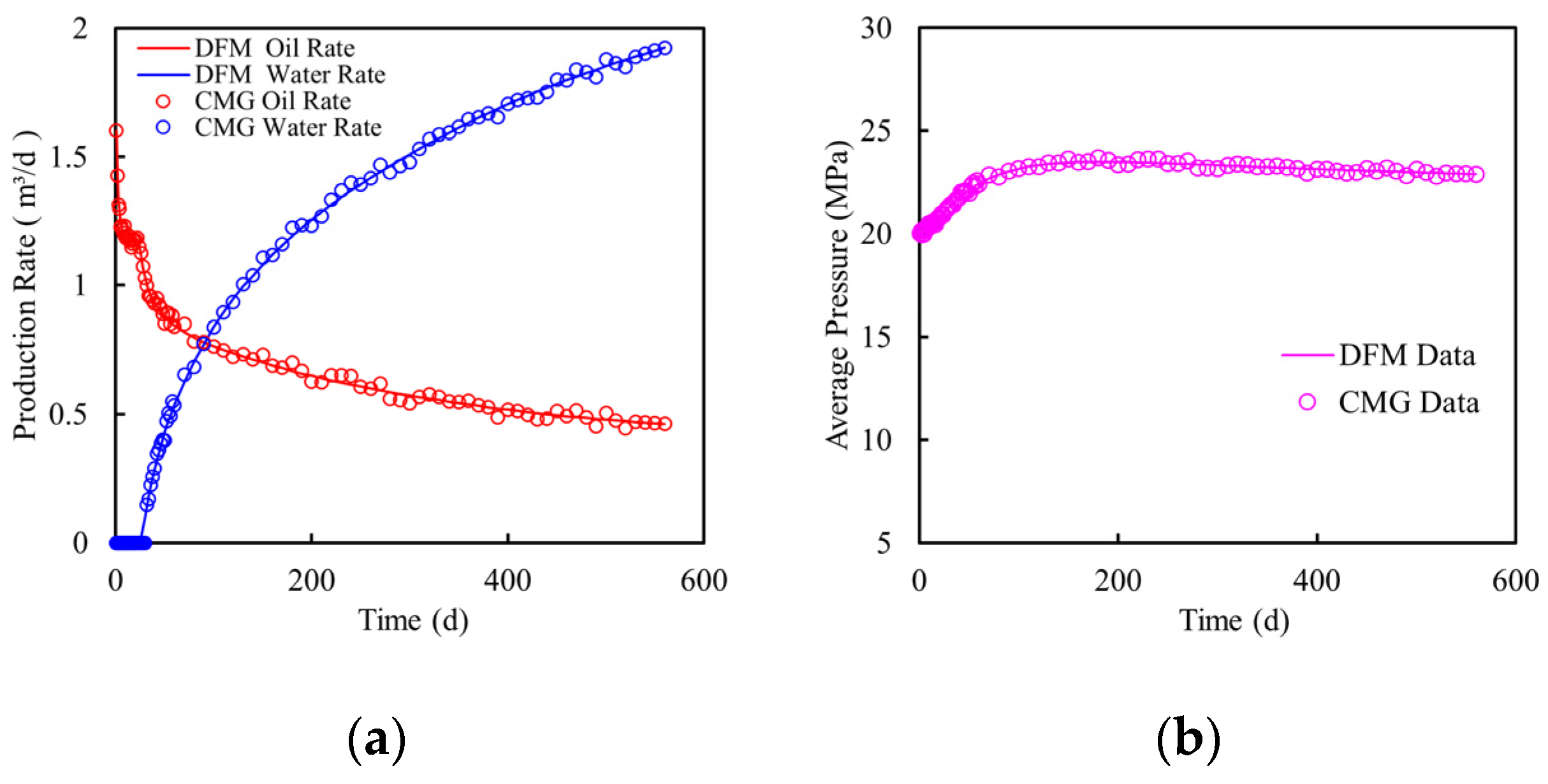
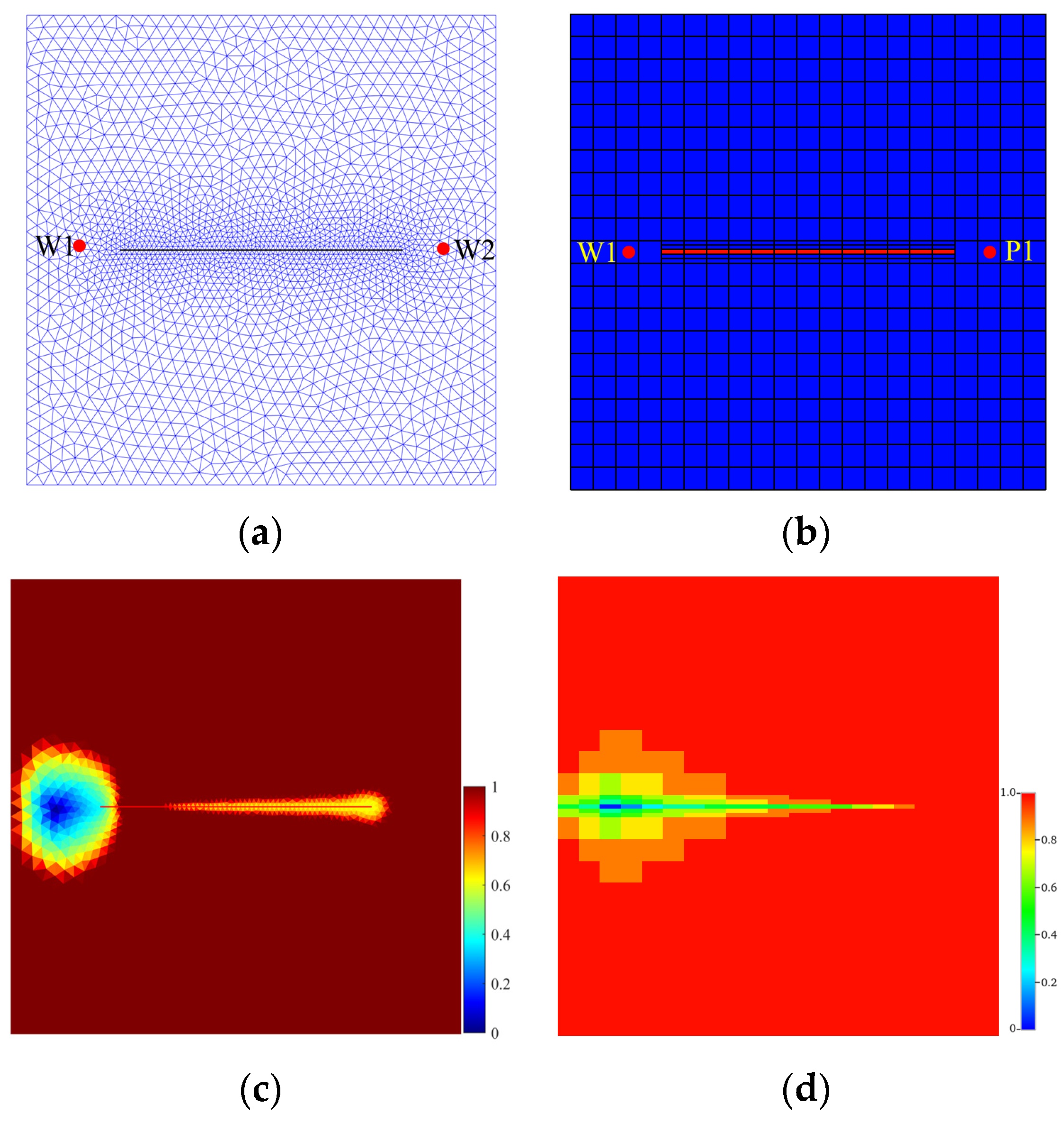
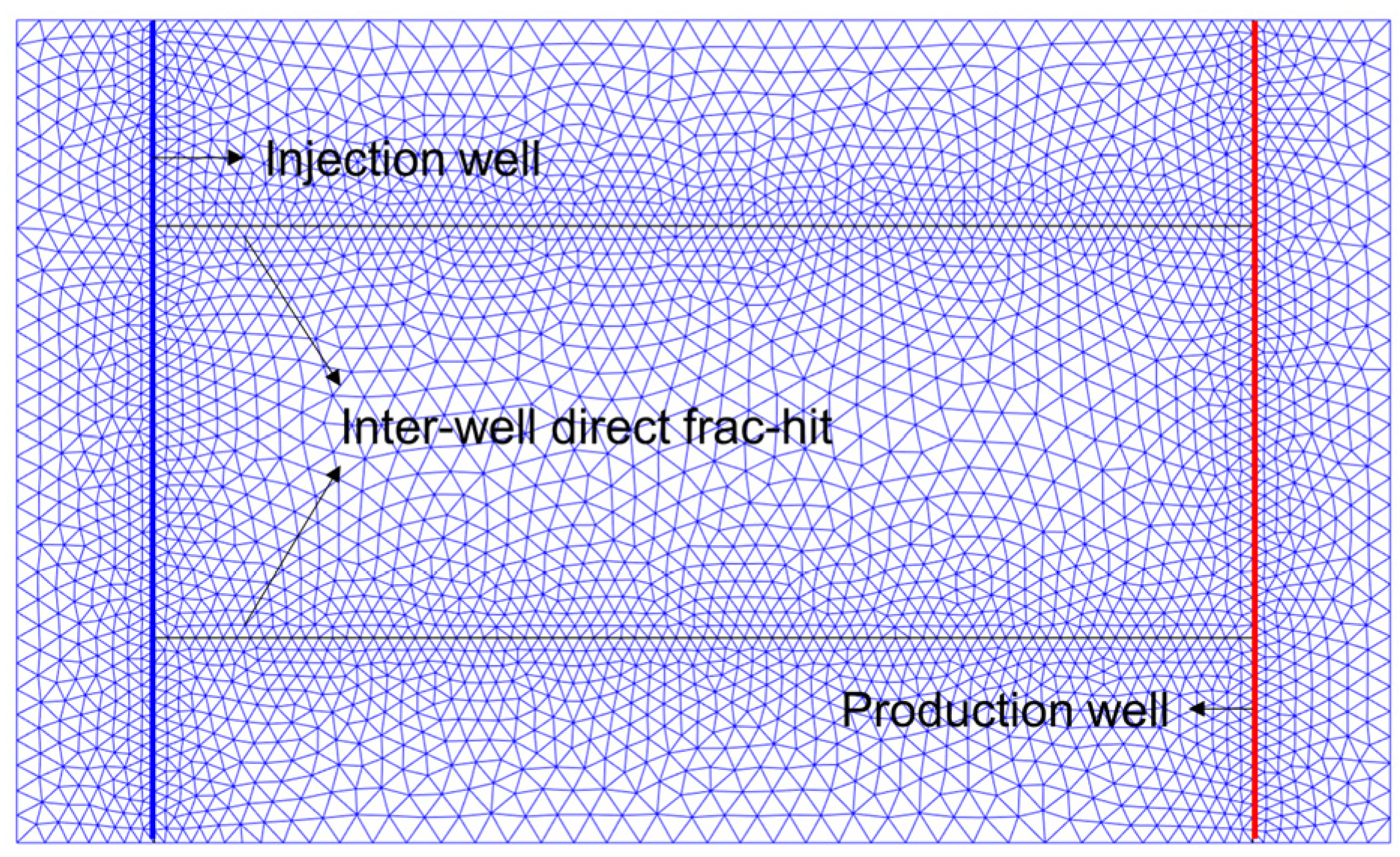
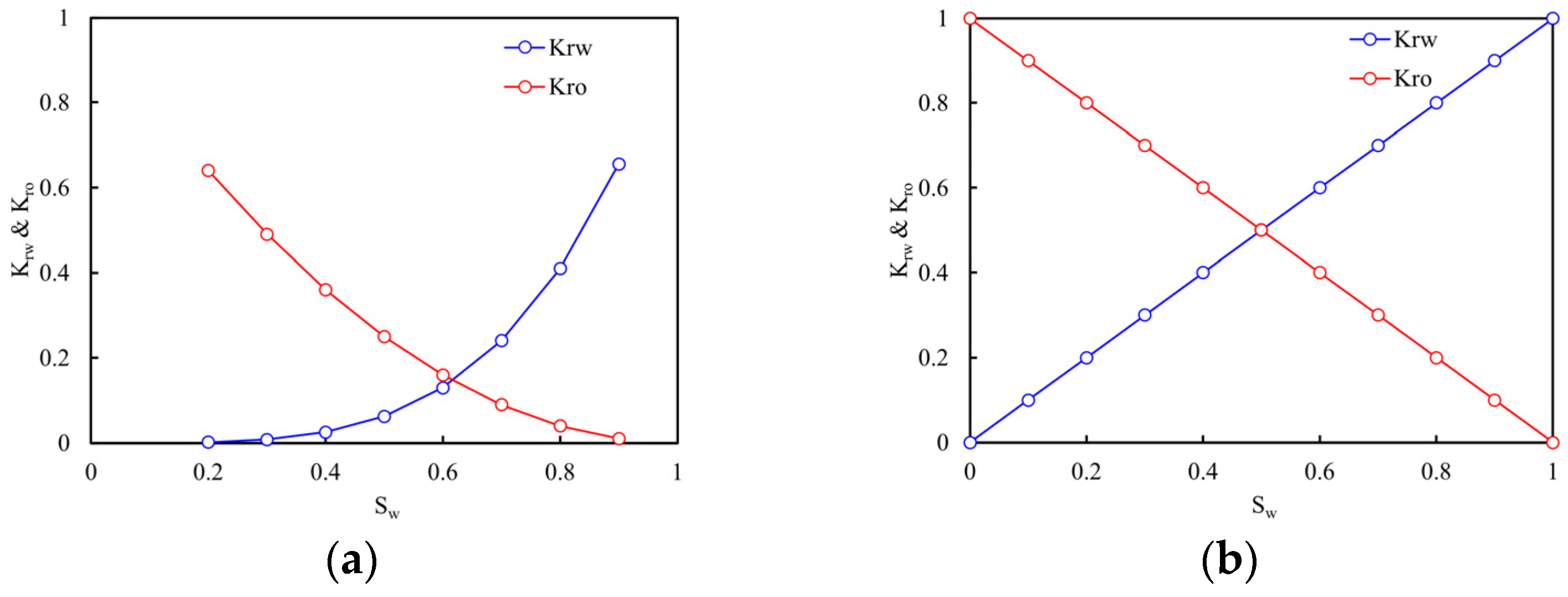





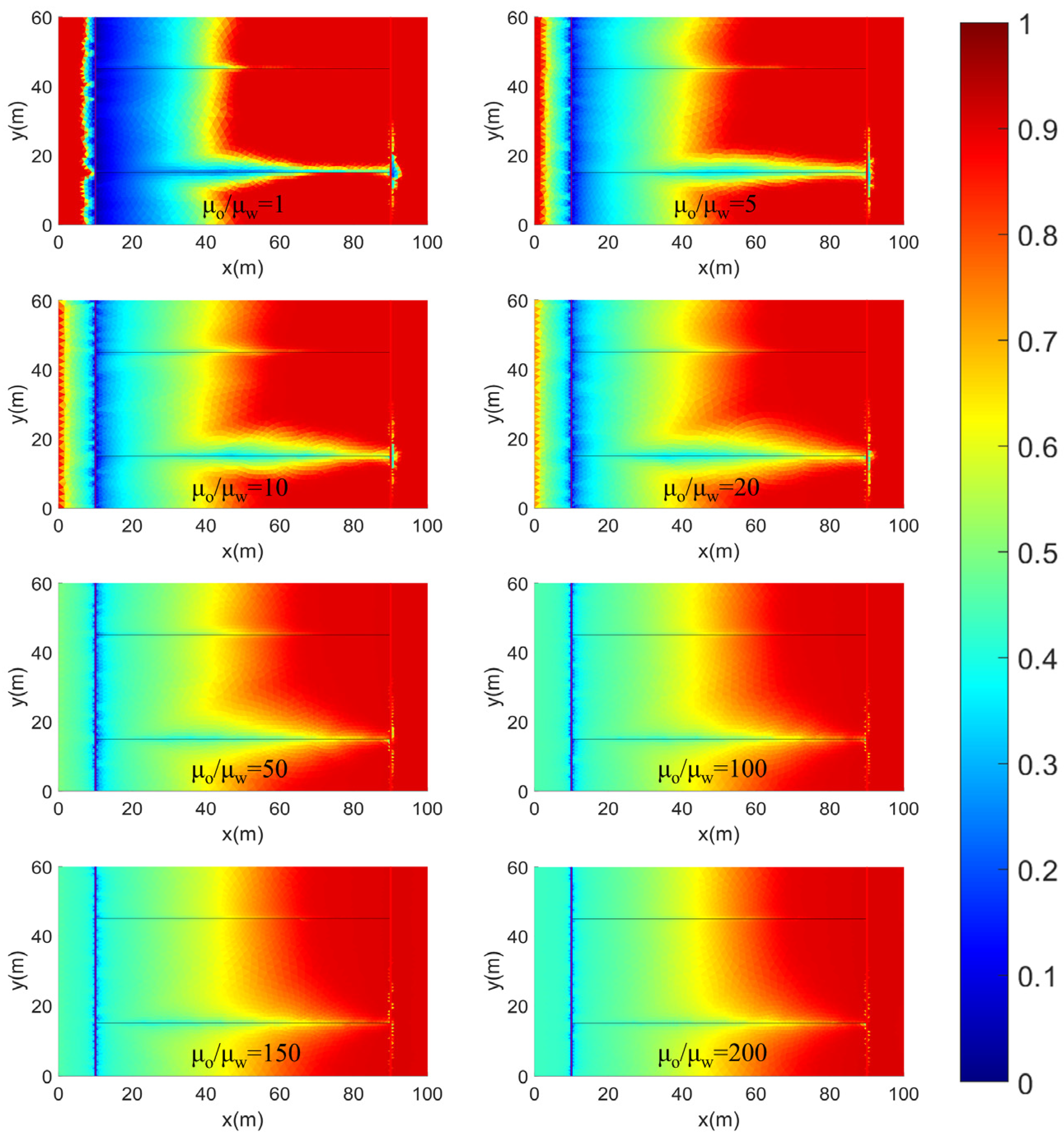

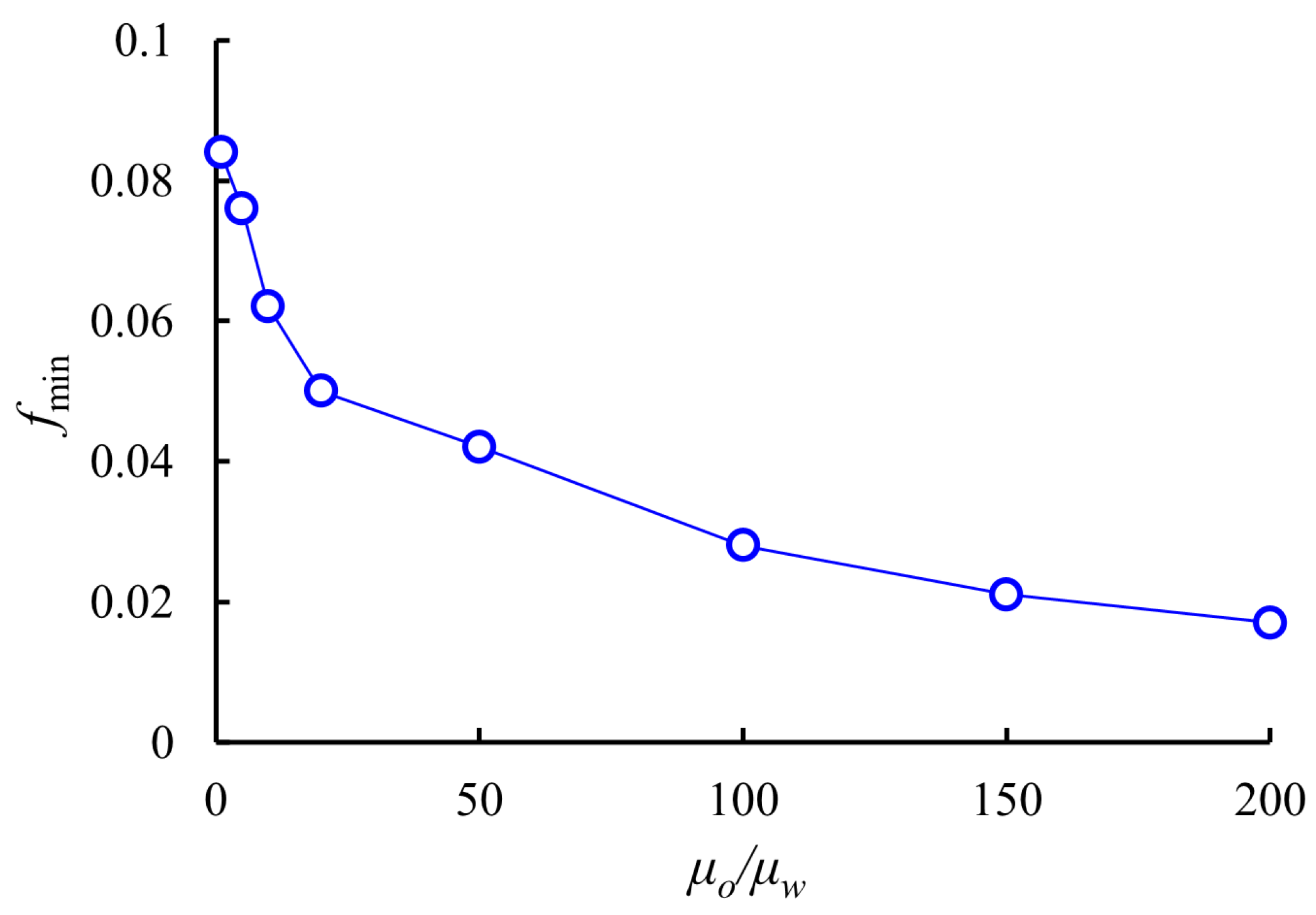

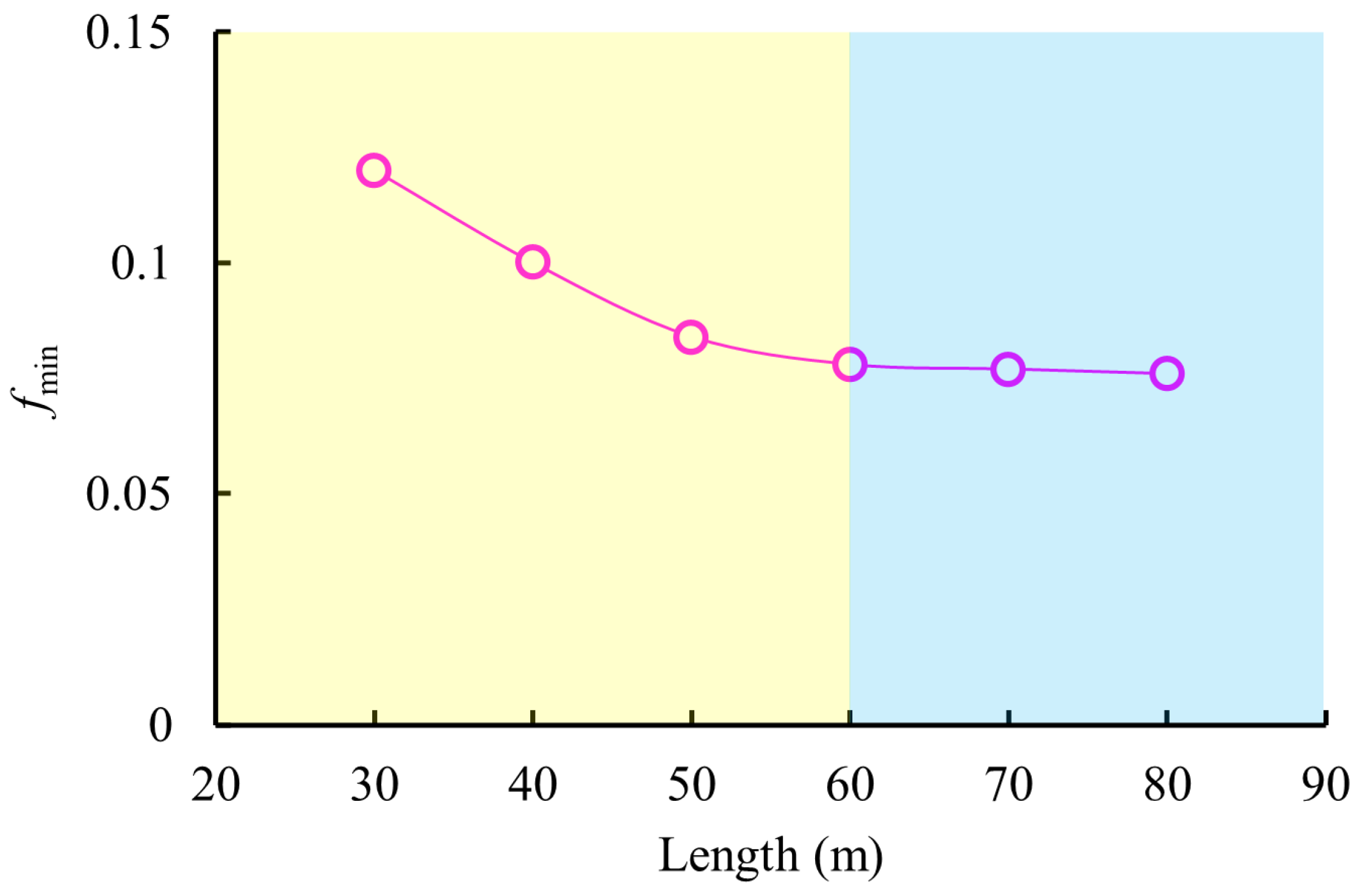
| Parameters | DFM Model | CMG Model |
|---|---|---|
| Fracture permeability (μm2) | 8.3 × 104 | 139 |
| Matrix permeability (μm2) | 1 | 1 |
| Fracture porosity | 0.45 | 0.45 |
| Matrix porosity | 0.15 | 0.15 |
| Oil viscosity (mPa·s) | 2 | 2 |
| Water viscosity (mPa·s) | 0.5 | 0.5 |
| Oil density (kg/m3) | 850 | 850 |
| Water density (kg/m3) | 1000 | 1000 |
| Fracture length (m) | 60 | 60 |
| Effective fracture width (m) | 0.001 | 0.6 |
| Initial pressure (MPa) | 12 | 12 |
| Injection pressure (MPa) | 30 | 30 |
| Bottom hole pressure (MPa) | 5 | 5 |
Disclaimer/Publisher’s Note: The statements, opinions and data contained in all publications are solely those of the individual author(s) and contributor(s) and not of MDPI and/or the editor(s). MDPI and/or the editor(s) disclaim responsibility for any injury to people or property resulting from any ideas, methods, instructions or products referred to in the content. |
© 2023 by the authors. Licensee MDPI, Basel, Switzerland. This article is an open access article distributed under the terms and conditions of the Creative Commons Attribution (CC BY) license (https://creativecommons.org/licenses/by/4.0/).
Share and Cite
Meng, F.; Wang, Y.; Song, X.; Hao, M.; Qin, G.; Qi, Y.; Ma, Z.; Wang, D. Numerical Simulation of Fracture Flow Interaction Based on Discrete Fracture Model. Processes 2023, 11, 3013. https://doi.org/10.3390/pr11103013
Meng F, Wang Y, Song X, Hao M, Qin G, Qi Y, Ma Z, Wang D. Numerical Simulation of Fracture Flow Interaction Based on Discrete Fracture Model. Processes. 2023; 11(10):3013. https://doi.org/10.3390/pr11103013
Chicago/Turabian StyleMeng, Fanle, Youjing Wang, Xinmin Song, Mingqiang Hao, Guosheng Qin, You Qi, Zunjing Ma, and Dong Wang. 2023. "Numerical Simulation of Fracture Flow Interaction Based on Discrete Fracture Model" Processes 11, no. 10: 3013. https://doi.org/10.3390/pr11103013





